初中代词语法大全
- 格式:docx
- 大小:45.10 KB
- 文档页数:19
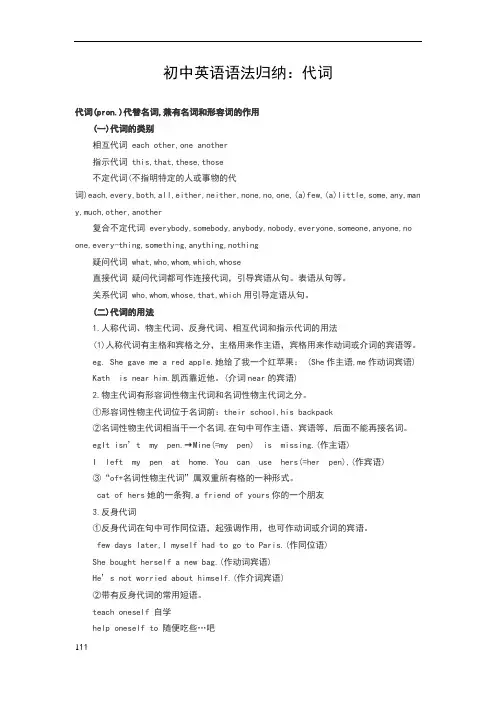
初中英语语法归纳:代词代词(pron.)代替名词,兼有名词和形容词的作用(一)代词的类别相互代词 each other,one another指示代词 this,that,these,those不定代词(不指明特定的人或事物的代词)each,every,both,all,either,neither,none,no,one,(a)few,(a)little,some,any,man y,much,other,another复合不定代词 everybody,somebody,anybody,nobody,everyone,someone,anyone,no one,every-thing,something,anything,nothing疑问代词 what,who,whom,which,whose直接代词疑问代词都可作连接代词,引导宾语从句。
表语从句等。
关系代词 who,whom,whose,that,which用引导定语从句。
(二)代词的用法1.人称代词、物主代词、反身代词、相互代词和指示代词的用法(1)人称代词有主格和宾格之分,主格用来作主语,宾格用来作动词或介词的宾语等。
eg. She gave me a red apple.她给了我一个红苹果: (She作主语,me作动词宾语) Kath is near him.凯西靠近他。
(介词near的宾语)2.物主代词有形容词性物主代词和名词性物主代词之分。
①形容词性物主代词位于名词前:their school,his backpack②名词性物主代词相当干一个名词,在句中可作主语、宾语等,后面不能再接名词。
egIt isn’t my pen.→Mine(=my pen) is missing.(作主语)I left my pen at home. You can use hers(=her pen),(作宾语)③“of+名词性物主代词”属双重所有格的一种形式。
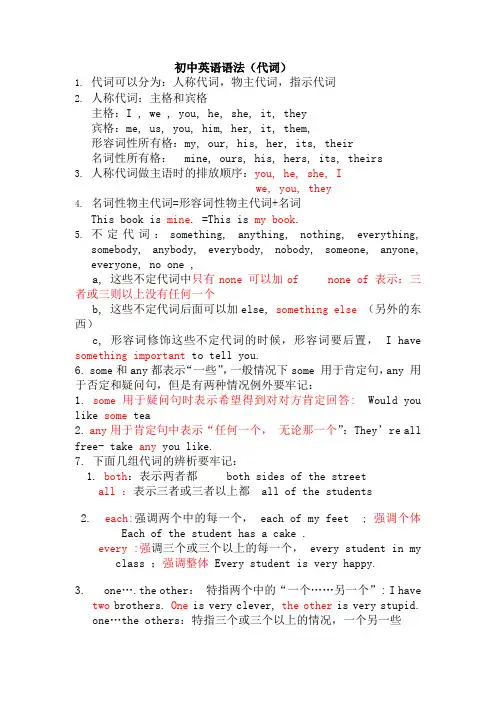
初中英语语法(代词)1.代词可以分为:人称代词,物主代词,指示代词2.人称代词:主格和宾格主格:I , we , you, he, she, it, they宾格:me, us, you, him, her, it, them,形容词性所有格:my, our, his, her, its, their名词性所有格: mine, ours, his, hers, its, theirs3.人称代词做主语时的排放顺序:you, he, she, Iwe, you, they4.名词性物主代词=形容词性物主代词+名词This book is mine. =This is my book.5.不定代词:something, anything, nothing, everything,somebody, anybody, everybody, nobody, someone, anyone, everyone, no one ,a, 这些不定代词中只有none 可以加of none of 表示:三者或三则以上没有任何一个b, 这些不定代词后面可以加else, something else (另外的东西)c, 形容词修饰这些不定代词的时候,形容词要后置, I have something important to tell you.6. some和any都表示“一些”,一般情况下some 用于肯定句,any 用于否定和疑问句,但是有两种情况例外要牢记:1. some用于疑问句时表示希望得到对对方肯定回答: Would you like some tea2.any用于肯定句中表示“任何一个,无论那一个”:They’re all free- take any you like.7. 下面几组代词的辨析要牢记:1. both:表示两者都 both sides of the streetall :表示三者或三者以上都 all of the students2. each:强调两个中的每一个, each of my feet ; 强调个体Each of the student has a cake .every :强调三个或三个以上的每一个, every student in my class ;强调整体Every student is very happy.3. one….the other:特指两个中的“一个……另一个”: I havetwo brothers. One is very clever, the other is very stupid.one…the others:特指三个或三个以上的情况,一个另一些There are four boys in the classroom. One is reading. The others are talking.one…the other +名词:特指三个或三个以上的情况,一个另一些There are four boys in the classroom. One is reading. The other boys are talking.4. some…the others:/some…others 在一个特定的范围内,“一些……,别的一些”The students are busy with the experiment. Some are operating the machine. The others are recording the results.5. one…another…the other/one…another…the third :表示列举三个人或三样事物The old woman has three daughters.One is in China.Another is in America. The other is in France.6.each other:表示两者中的相互After the tennis match, the two players shook hands with each other.one another:表示三者,三者以上的相互After the football match, all the players shook hands with one another.。

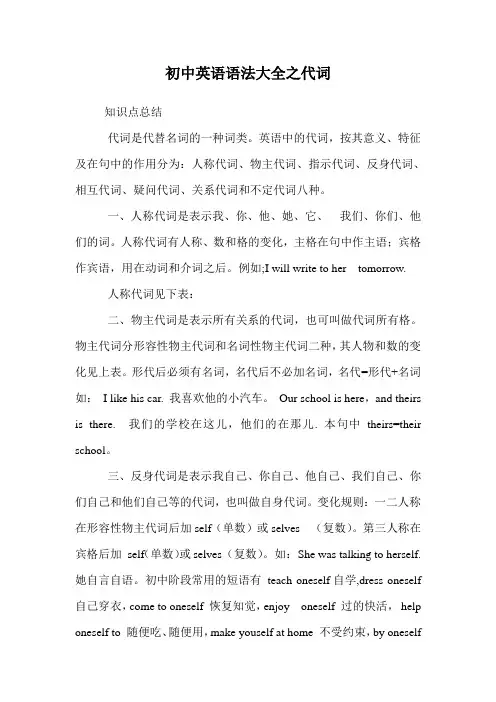
初中英语语法大全之代词知识点总结代词是代替名词的一种词类。
英语中的代词,按其意义、特征及在句中的作用分为:人称代词、物主代词、指示代词、反身代词、相互代词、疑问代词、关系代词和不定代词八种。
一、人称代词是表示我、你、他、她、它、我们、你们、他们的词。
人称代词有人称、数和格的变化,主格在句中作主语;宾格作宾语,用在动词和介词之后。
例如;I will write to her tomorrow.人称代词见下表:二、物主代词是表示所有关系的代词,也可叫做代词所有格。
物主代词分形容性物主代词和名词性物主代词二种,其人物和数的变化见上表。
形代后必须有名词,名代后不必加名词,名代=形代+名词如:I like his car. 我喜欢他的小汽车。
Our school is here,and theirs is there. 我们的学校在这儿,他们的在那儿. 本句中theirs=their school。
三、反身代词是表示我自己、你自己、他自己、我们自己、你们自己和他们自己等的代词,也叫做自身代词。
变化规则:一二人称在形容性物主代词后加self(单数)或selves (复数)。
第三人称在宾格后加self(单数)或selves (复数)。
如:She was talking to herself. 她自言自语。
初中阶段常用的短语有teach oneself自学,dress oneself 自己穿衣,come to oneself 恢复知觉,enjoy oneself 过的快活,help oneself to 随便吃、随便用,make youself at home 不受约束,by oneself独自地; 单独地,speak to oneself 自言自语四、指示代词有this,that,these,those等。
This,those在一些句子中代替前面的名词以避免重复,如:The weather in Beijing is colder than that in Guangzhou. 这种题型经常在考试中出现。
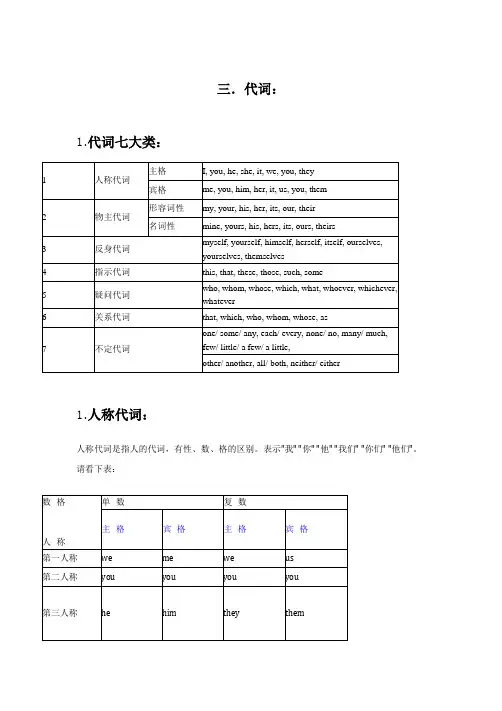
三.代词:1.代词七大类:1人称代词主格I, you, he, she, it, we, you, they宾格me, you, him, her, it, us, you, them2物主代词形容词性my, your, his, her, its, our, their名词性mine, yours, his, hers, its, ours, theirs3反身代词myself, yourself, himself, herself, itself, ourselves, yourselves, themselves4指示代词this, that, these, those, such, some5疑问代词who, whom, whose, which, what, whoever, whichever, whatever6关系代词that, which, who, whom, whose, as7不定代词one/ some/ any, each/ every, none/ no, many/ much, few/ little/ a few/ a little,other/ another, all/ both, neither/ either1.人称代词:人称代词是指人的代词,有性、数、格的区别。
表示"我" "你" "他" "我们" "你们" "他们"。
请看下表:数格人称单数复数主格宾格主格宾格第一人称we me we us第二人称you you you you 第三人称he him they themshe herit it(1)人称代词主格在句中作主语。
例如:She is my English teacher.(2)宾格在句中作宾语。
例如:They don't want me to go there alone.Don't worry. I can look after her.(3)宾格还可以作宾格。

初中英语语法代词讲解文档编制序号:[KKIDT-LLE0828-LLETD298-POI08]初中英语语法代词代词:为了避免重复而用来代替其他词的词。
种类:1) 人称 2) 物主 3) 反身4) 指示 5)不定6) 疑问7) 相互代词:each other, one another互相,其所有格加-’s8) 关系代词:which, who,that,whom,whose等引导定语从句9) 连接代词:who, whom, whose, what, which, whatever, whichever, whoever, whomever10)替代词:one(单数), ones(复数)用于替代前面出现的同类事物。
但ones必须和形容词连用。
如果替代的名词时无形容词在前,则用some, any,而不用ones。
如:Have you bought any rulers Yes,I 've bought some.一、人称代词1.人称代词的形式2.人称代词的句法功能3.人称代词的排列顺序(单数231,复数123)当两个以上的人称代词一起作主语时,单数按二、三、一人称排列(即you, he / she, I);复数按一、二、三人称排列(即we, you, they)。
但是如果做错了事需要承担责任时,要把说话人(I)放在第一位。
如:It was I and John that made her angry. 是我和约翰惹她生气了。
二、物主代词1.物主代词的形式2.物主代词的基本用法3.物主代词的特殊用法在双重所有格中只能用名词性物主代词。
如:我的一个朋友a friend of mine ,她的一个同学 a classmate of hers , each brother of his.三、反身代词1.反身代词的形式反身代词又叫自身代词,表示动作返回到动作发出者本身。
2.反身代词的句法功能3.由反身代词构成的习惯用语①help oneself to 随便吃……②come to oneself 苏醒过来,醒悟,恢复知觉③dress oneself 自己穿衣服④say to oneself 自言自语⑤enjoy oneself 玩得开心⑥lose oneself in迷路于,全神贯注于…之中,消失于⑦teach oneself 自学⑧look after oneself ⑨by oneself 亲自learn……by oneself 自学…leave one by oneself 把某人单独留下hurt oneself 伤了自己make yourself/yourselves at home 不必拘束四、指示代词1. that 用来代替前面提到的不可数名词,those代替复数名词。
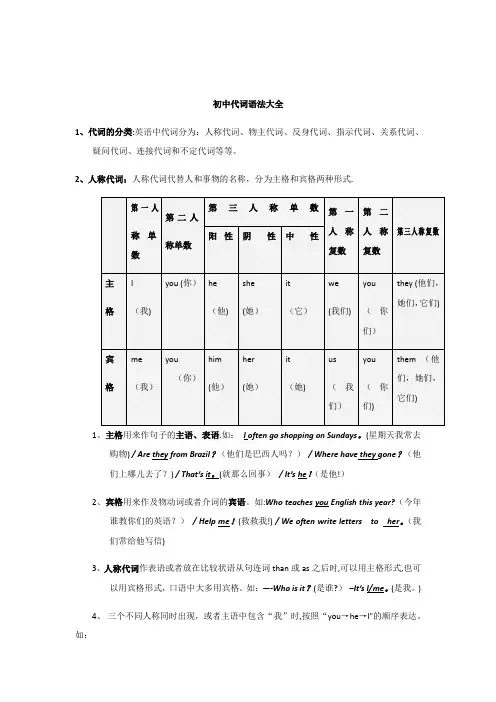
初中代词语法大全1、代词的分类:英语中代词分为:人称代词、物主代词、反身代词、指示代词、关系代词、疑问代词、连接代词和不定代词等等。
2、人称代词:人称代词代替人和事物的名称,分为主格和宾格两种形式.1、主格用来作句子的主语、表语.如:I often go shopping on Sundays。
(星期天我常去购物) / Are they from Brazil?(他们是巴西人吗?)/ Where have they gone?(他们上哪儿去了?)/ That’s it。
(就那么回事)/ It’s he!(是他!)2、宾格用来作及物动词或者介词的宾语。
如:Who teaches you English this year?(今年谁教你们的英语?)/ Help me!(救救我!) / We often write letters to her。
(我们常给他写信)3、人称代词作表语或者放在比较状语从句连词than或as之后时,可以用主格形式,也可以用宾格形式,口语中大多用宾格。
如:—-Who is it?(是谁?)–It’s I/me。
(是我。
)4、三个不同人称同时出现,或者主语中包含“我”时,按照“you→he→I"的顺序表达。
如:Both he and I are working at that computer company。
(我和他都在那家电脑公司上班) –Who will go there?(谁要去那儿?) –You and me。
(你和我)5、人称代词it除了可以指人指物之外,还可以表示“时间、天气、温度、距离、情况"等含义,此外还可以作“非人称代词”使用,替代作主语或者宾语的不定式、动名词或者名词性从句。
如:——What’s the weather like today?(今天天气怎样?)—It’sfine。
(天气晴好)/ —-What’s the ti me?(几点啦?)–It’s 12:00。


初中英语语法-代词讲解初中英语语法代词代词:为了避免重复而用来代替其他词的词。
种类:1)人称2)物主3)反身4)指示5)不定6)疑问7)相互代词:each other, one another互相,其所有格加-’s8)关系代词:which,who,that,whom,whose等引导定语从句9)连接代词:who, whom, whose, what, which, whatever, whichever, whoever, whomever10)替代词:one(单数),ones(复数)用于替代前面出现的同类事物。
但ones必须和形容词连用。
如果替代的名词时无形容词在前,则用some, any,而不用ones。
如:Have you bought any rulers?Yes,I 've bought some.一、人称代词1.人称代词的形式主格宾格第一人称Ime功能主格作主语作动词宾语宾格作介词宾语作表语指时间指天气指间隔单数第二人称youyouhehim第三人称sheheritit例句Theyare fourteen years old. /Sheis a Chinese teacher. The box is too heavy. Let me helpyou. / I likeitvery much. Mary didn’t want to go withme.--- Who is standing over there?---It’sme.Itis early spring, but it’s already very hot.Itrained ________________(大)last night.复数第一weus第二youyou第三theythem2.人称代词的句法功用It’s about five ___________(minute)walk from here to the library.How far is it from your school to your home?I finditeasy to learn English well.-Where’s my book?-It’s over there.it的特殊用法作方式主语、Itis very nice of you to help me.方式宾语指前文提到的物指不知性别的婴儿或不确指性此外人The baby is crying. It may be hungry.3.人称代词的布列按次(单数231,复数123)当两个以上的人称代词一同作主语时,单数按2、3、一人称布列(即you, he / she, I);复数按1、2、三人称布列(即we, you, they)。

中考初中英语语法--代词一.人称代词(一)形式二.物主代词(一)形式(二)用法练一练一.写出代词形式二.用所给代词的适当形式填空1. That is not _________ kite. That kite is very small, but _________ is very big. ( I )2. The dress is _________. Give it to _________. ( she )3. Is this _________ watch? (you) No, it’s not _________ . ( I )4. _________ is my brother. ________ name is Jack. Look! Those stamps are _________. ( he )5. _________ dresses are red. (we) What colour are _________? ( you )6. Here are many dolls, which one is _________ ? ( she )7. I can find my toy, but where’s _________? ( you )8. Show _________ your kite, OK? (they)9. I have a beautiful cat. _________name is Mimi. These cakes are _________. ( it )10. Are these ________ tickets? No, ________ are not _________. ________ aren’t here. ( they )11. Shall _________ have a look at that classroom? That is _________ classroom. ( we )12. _________ is my aunt. Do you know _________ job? ( she )13. That is not _________ camera. _________is at home. ( he )14. Where are _________? I can’t find _________. Let’s call _________ parents. ( they )15. _________ don’t know her name. Would you please tell _________. ( we )16. So many dogs. Let’s count _________. ( they )17. I have a lovely brother. _________ is only 3. I like _________ very much. ( he )18. May I sit beside _________? ( you )19.The girl behind _________ is our friend. (she )20. They want a football . Give _______the green one, please. ( they )21.My skirt is better than_________. ( you)22.Mr. Smith is an old friend of_________ ( I).23. Mary, help _________to the bananas, please. ( you )24.They all enjoyed _________ at the party. ( they )25.Mr Wang teaches ______ maths and I teach ______computer.(I)参考答案:二.1.my;mine 2.hers; her 3.your;mine 4.He;His;his 5.Our;yours 6.hers 7.yours 8.them 9.Its ;its 10.their;they; theirs; Theirs 11. we; our 12.She;her 13.his; His 14.they;them;their 15.We;us 16.them 17.He;him 18.you 19.her 20.them 21.yours 22.mine 23.yourself 24. themselves25.me; myself一、英语阅读理解专项练习试卷1.阅读下列短文, 从每题所给的四个选项(A、B、C和D)中选出最佳选项。
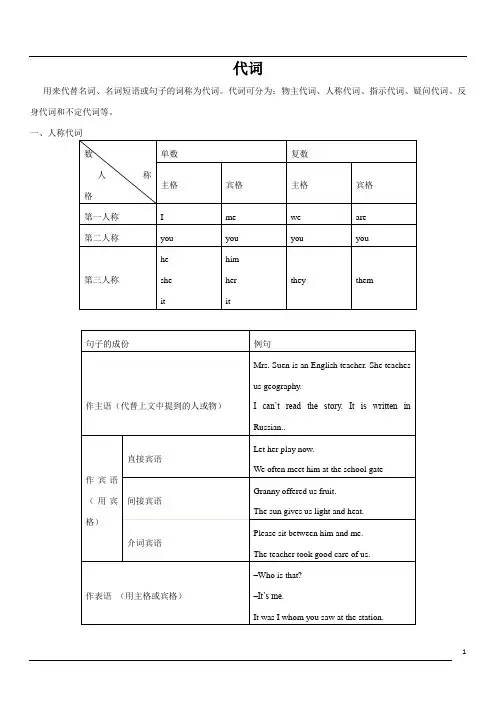
代词用来代替名词、名词短语或句子的词称为代词。
代词可分为:物主代词、人称代词、指示代词、疑问代词、反身代词和不定代词等。
一、人称代词数人称格单数复数主格宾格主格宾格第一人称I me we are 第二人称you you you you第三人称hesheithimheritthey them句子的成份例句作主语(代替上文中提到的人或物)Mrs. Suen is an English teacher. She teaches us geography.I can’t read the story. It is written in Russian..作宾语(用宾格)直接宾语Let her play now.We often meet him at the school gate 间接宾语Granny offered us fruit.The sun gives us light and heat.介词宾语Please sit between him and me.The teacher took good care of us.作表语(用主格或宾格)–Who is that?–It’s me.It was I whom you saw at the station.1.人称代词不仅仅指人,也可以指事或物。
2.人称代词主格单数he, she和it的复数,都是they,宾格形式也相同,为them。
3.第三人称的人称代词分阳性he(him),阴性she(her)和中性it(it),复数只有一个形式they(them),不分性别。
4.选用什么人称代词,取决于所要代替的名词。
在数和性上要与所代替的名词保持一致。
5.单数人称代词作并列主语时,用“二三一(you, she/he and I)”;复数人称代词作并列主语时,用“一二三(we, you and they)”.6.在承认错误、担当责任时,把说话人I 放在首位。
初中英语语法——代词代词(pron.)的含义是:代替名词,兼有名词和形容词的作用代词包括:人称代词,物主代词,反身代词类别:主格宾格形容词性物主代词名词性物主代词反身代词第一人称单数单数:I me my mine myself 复数:we us our ours ourselves第二人称单数:you you your yours yourself 复数:you you your yours yourselves第三人称单数:he him his his himself she her her hers herself it it its its itself 复数:they them their theirs themselves1.人称代词A.人称代词it的特殊用法:一般it指“它”,但在表示天气、时间、距离等时,用it来代替,此时的it并不译为“它”。
B.当三个人称代词(单数)同时出现时,其先后顺序为you,he,I。
而复数一般采用we,you,they顺序。
2.物主代词A.形容词性物主代词后面一定要跟上一个名词。
B.名词性物主代词可作主语、表语、宾语。
3.反身代词1)反身代词的构成分两种:第一、二人称反身代词在形容词:性物主代词后加上self或selves,第三人称的反身代词在宾格代词后加上self或selves.2)反身代词的用法:一种是作宾语,由主语发出的动作又回到动作者本身。
如:I enjoyed myself at the party.另一种是作名词或代词的同位语;用来加强语气。
如:I can do it myself.3)初中阶段由反身代词构成的常用词组有:enjoy oneself,help oneself to,learn by oneself,teach oneself,(all)by oneself,leave...by oneself,lose oneself in等,在运用反身代词时,应注意它在数、性别上与哪一个保持一致。
初中英语语法代词代词:为了避免重复而用来代替其他词的词。
种类:1)人称2)物主3)反身4)指示5)不定6)疑问7)相互代词:eachother,oneanother互相,其所有格加-’s8)关系代词:which,who,that,whom,whose等引导定语从句2.?人称代词的句法功能3.?1.?2.?物主代词的基本用法3.?物主代词的特殊用法在双重所有格中只能用名词性物主代词。
如:我的一个朋友afriend ofmine?,?她的一个同学aclassmateofhers,eachbrotherofhis.三、反身代词??①?helponeselfto随便吃……???②?cometooneself苏醒过来,醒悟,恢复知觉??③?dressoneself自己穿衣服??④?saytooneself自言自语??⑤?enjoyoneself玩得开心??⑥?loseoneselfin迷路于,全神贯注于…之中,消失于??⑦?teachoneself自学???⑧?lookafteroneself⑨byoneself 亲自learn……byoneself自学…leaveonebyoneself把某人单独留下hurtoneself伤了自己makeyourself/yourselvesathome不必拘束1.不(对)Headmiredthatwhichlookedbeautiful. 他赞赏外表漂亮的东西。
(对)Headmiredthosewholookedbeautiful.他赞赏那些外表漂亮的人。
(those指人)(错)Headmiredthatwhodancedwell. (that作宾语时不能指人)(对)Headmiredthosewhodancedwell. 他赞赏跳舞好的人。
(those指人)(对)Headmiredthosewhichlookedbeautiful.他赞赏那些外表漂亮的东西。
(those指物)语,在口语中作宾语时,可用who代替,但在介词后只能用whom,例如:Who(m)didyoumeetonthestreet? 你在街上遇到了谁?(作动词宾语)Who(m)areyoutakingthebookto? 你要把这书带给谁?(作介词宾语,置句首)Towhomdidyouspeakonthecampus?你在校园里和谁讲话了?(作介词宾语,置介词后,不能用who取代。
初中代词语法大全1、代词得分类:英语中代词分为:人称代词、物主代词、反身代词、指示代词、关系代词、疑问代词、连接代词与不定代词等等、2、人称代词:人称代词代替人与事物得名称,分为主格与宾格两种形式、1、主格用来作句子得主语、表语。
如:I often go shopping on Sundays、(星期天我常去购物)/ Are they fromBrazil?(她们就是巴西人吗?)/ Wherehave they gone?(她们上哪儿去了?)/ That'sit。
(就那么回事)/It’she!(就是她!)2、宾格用来作及物动词或者介词得宾语。
如:Who teaches you Englishthis year?(今年谁教您们得英语?)/Help me!(救救我!) /Weoftenwriteletters to her、(我们常给她写信)3、人称代词作表语或者放在比较状语从句连词than或as之后时,可以用主格形式,也可以用宾格形式,口语中大多用宾格。
如:—-Who is it?(就是谁?)–It’sI/me、(就是我、)4、三个不同人称同时出现,或者主语中包含“我"时,按照“you→he→I”得顺序表达。
如:Bothheand I are working atthatputer company、(我与她都在那家电脑公司上班)–Whowill go there?(谁要去那儿?)–You andme.(您与我)5、人称代词it除了可以指人指物之外,还可以表示“时间、天气、温度、距离、情况”等含义,此外还可以作“非人称代词”使用,替代作主语或者宾语得不定式、动名词或者名词性从句。
如:--What’s theweather liketoday?(今天天气怎样?)—It'sfine.(天气晴好) / -—What’s the time?(几点啦?)–It’s 12:00。
(12点)/ It'salong way togo。
外教一对一初中英语语法大全 -代词语法要点代词(pronoun)是替代名词或名词短语的词。
例如:I 我you 你he 他we 我们 they 他们it 它代词的种类很多,有人称代词、物主代词、反身代词、相互代词、指示代词、疑问代词、关系代词和不定代词。
代词在句子中可以作主语、宾语、表语或定语。
一、代词的种类和意义代词分为人称代词、物主代词、反身代词、相互代词、指示代词、疑问代词、关系代词和不定代词。
二、代词详解1. 人称代词人称代词有三种人称,分别叫第一人称、第二人称和第三人称,各人称都有单、复数形式,同时还有主格和宾格之分。
人称代词(主格、宾格)在句子中的作用人称代词的主格形式在句子中作主语;宾格形式在句子中作宾语,可作动词的宾语,也可作介词的宾语;如果跟在连系动词的后面,它们还可以作表语。
外教一对一 人称代词有时还可以指代“人”以外的其他事物。
这种用法很像我们汉语修辞中的“拟人”手法,有一定的感情色彩。
以she为例,在特定的语境中,“她”可以指代moon(月亮),sea(海洋),earth(地球),country(国家),peace(和平),等等。
两个或三个单数的人称代词并列连用时,其规则与汉语不同。
汉语说“我和你”、“我和他”,英语则说“you and I”、“he and I”;汉语说“我你他”,英语则说“you,he and I”。
而复数人称连用时,规则和汉语基本一致:“我们和你们”说“you and we ”,“我们和他们”说“we and they”,“我们,你们和他们”说“we,you and they ”。
人称代词it除了作“它”解之外,还可以指代多种“人”、“事”、“物”。
2. 物主代词物主代词有形容词性物主代词和名词性物主代词两种。
物主代词的用法形容词性物主代词均表示“某人的”或“某物的”,用在名词之前,作该名词的定语;名词性物主代词用于一定的语境中,用来代替前面提到的人或事物,具有名词性质,在句子中可以有部分名词的作用,因此可以作主语、宾语和表语。
初中代词语法大全1、代词的分类:英语中代词分为:人称代词、物主代词、反身代词、指示代词、关系代词、疑问代词、连接代词和不定代词等等。
2、人称代词:人称代词代替人和事物的名称,分为主格和宾格两种形式。
1、主格用来作句子的主语、表语。
如:IoftengoshoppingonSundays.(星期天我常去购物)/AretheyfromBrazil?(他们是巴西人吗?)/Wherehavetheygone?(他们上哪儿去了?)/That’s it.(就那么回事)/It’s he!(是他!)2、宾格用来作及物动词或者介词的宾语。
如:WhoteachesyouEnglishthisyear?(今年谁教你们的英语?)/Helpme!(救救我!)/Weoftenwriteletterstoher.(我们常给他写信)3、人称代词作表语或者放在比较状语从句连词than或as之后时,可以用主格形式,也可以用宾格形式,口语中大多用宾格。
如:--Whoisit?(是谁?)–It’s I/me.(是我。
)4、三个不同人称同时出现,或者主语中包含“我”时,按照“you→he→I”的顺序表达。
如:BothheandIareworkingatthatcomputercompany.(我和他都在那家电脑公司上班)–Whowillgothere?(谁要去那儿?)–Youandme.(你和我)5、人称代词it除了可以指人指物之外,还可以表示“时间、天气、温度、距离、情况”等含义,此外还可以作“非人称代词”使用,替代作主语或者宾语的不定式、动名词或者名词性从句。
如:--What’stheweatherliketoday?(今天天气怎样?)—It’sfine.(天气晴好)/--What’sthetime?(几点啦?)–It’s12:00.(12点)/It’salongwaytogo.(那可要走好长的路)/Ittookhimthreedaystocleanhishouse.(打扫屋子花了他三天的时间)/Itisveryclearthatthepublicwanttoknowwhenthesemencangointospace.(很显然,公众想知道这些人什么时候能进入太空)/Wefounditverydifficulttolearnaforeignlanguagewell.(我们发觉要学好一门外语是非常困难的)3、物主代词:说明事物所属关系的代词,分为形容词性和名词性两种。
初中代词语法大全1、代词的分类:英语中代词分为:人称代词、物主代词、反身代词、指示代词、关系代词、疑问代词、连接代词和不定代词等等。
2、人称代词:人称代词代替人和事物的名称,分为主格和宾格两种形式。
1、主格用来作句子的主语、表语。
如:I often go shopping on Sundays.(星期天我常去购物) / Are they from Brazil?(他们是巴西人吗?) / Where have theygone?(他们上哪儿去了?)/ That’s it.(就那么回事)/ It’s he!(是他!)2、宾格用来作及物动词或者介词的宾语。
如:Who teaches you English this year?(今年谁教你们的英语?) / Help me!(救救我!) / We often write letters to her.(我们常给他写信))3、人称代词作表语或者放在比较状语从句连词than或as之后时,可以用主格形式,也可以用宾格形式,口语中大多用宾格。
如:--Who is it?(是谁?)–It’s I/me.(是我。
)4、三个不同人称同时出现,或者主语中包含“我”时,按照“you→he→I”的顺序表达。
如:Both he and I are working at that computer company.(我和他都在那家电脑公司上班) –Who will go there?(谁要去那儿?) –You and me.(你和我)5、人称代词it除了可以指人指物之外,还可以表示“时间、天气、温度、距离、情况”等含义,此外还可以作“非人称代词”使用,替代作主语或者宾语的不定式、动名词或者名词性从句。
如:--What’s the weather like today?(今天天气怎样?)—It’s fine.(天气晴好)/ --What’s the time?(几点啦?)–It’s 12:00.(12点) / It’s a long way to go.(那可要走好长的路) / It took him threedays to clean his house.(打扫屋子花了他三天的时间)/ It is very clear that the public want to know when these men can go into space.(很显然,公众想知道这些人什么时候能进入太空) / We found it very difficult to learn a foreign language well.(我们发觉要学好一门外语是非常困难的)3、物主代词:说明事物所属关系的代词,分为形容词性和名词性两种。
1、形容词性物主代词只能作句子中名词的修饰语,后面要跟名词。
如:Is that your umbrella?(那是你的伞吗?) / I often go to see my aunt on Sundays.(我经常在星期天去看望阿姨) / They are their books.(是他们的书)2、名词性物主代词相当于名词,既代替事物又表明所属关系,在句子中往往独立地作主语、宾语或者表语,后面千万不可以跟名词。
如:This is your cup,but where is mine?(这是你的杯子,可我的在哪儿?) / Your classroom is very big, but ours is rather small.(你们的教室很大,我们的相当小)3、“of + 名词性物主代词”称为双重所有格,作定语时放在名词的后面。
如:A friend of mine came to see me yesterday.(我的一个朋友昨天来看我了) (指若干朋友中有一个来看我。
)[试比较] My friend came to see me yesterday.(我的朋友昨天来看我了)(指我的那个特定的朋友来看我。
)、4、反身代词:表示谓语的动作与主语有关或者宾语补足语的动作与宾语有关。
;1、反身代词在句子中作宾语表示反射(指一个动作回到该动作执行者本身)。
如:Don’t play with the knife, you might hurt yourself.(不要玩刀子,那会割伤你的)2、在句子中作同位语表示强调(即用来强调名词或代词的语气)。
如:The story itself is good. Only he didn’t tell it well.(故事本身是好的,只是他没有讲好)6、指示代词:指示说明近处或者远处、上文或者下文、以前或者现在的人或事物。
指示代词既可以单独使用做句子的主语、宾语或表语,也可以作定语修饰名词。
如:What’s this?(这是什么?) / That model plane is made of plastic.(那只模型飞机是塑料做的)(被动句) / Remember never to do such things.(记得永远不要做这样的事情)/ Do the same as the teacher tells you. (按老师说的做)/ ---Who is it?(是谁?) ---It’s me!(是我!)6、关系代词:用来引导定语从句的代词叫关系代词,参见后面的定语从句。
$1、关系代词who 、which、 that 、whom 等,将定语从句和主句连接起来。
英语中的关系代词一方面在从句中担任一定的成分,另一方面又起连接作用。
如:The student who is drawing a picture is in Grade One.(正在画画的学生是一年级的)2、关系代词who / whom指人,如果作从句的宾语,则有时省略。
如:Do you know the man who is wearing a red hat? (你认识那个戴着红帽子的男人吗?)3、关系代词which指物,如果作从句的宾语,则有时省略。
如:Have you found the bookwhich you lost several days ago?(你找到几天前丢失的那本书了吗?)4、关系代词that既可指人也可指物,如果作从句的宾语,则有时省略。
如:Can you seethe man/dog that is running along the river bank ?(你看得见顺着河跑的男人/狗了吗?)7、连接代词:用来引导宾语从句、主语从句或表语从句的连接词称连接代词。
英语中连接代词主要有:what(什么),who(谁),whom(谁),which(哪个),whose(谁的)。
详见相应从句。
(8、不定代词:代替或修饰不特指的人或事物的代词叫不定代词。
※注:复合不定代词有12个:something(某事), someone(某人), somebody(某人), anything(任何事), anyone(任何人), anybody(任何人), nothing(没事),nobody(没有人), no one(没有人), everything(一切), everyone(每个人), everybody(每个人)."(1)some和 any 的用法:some一般用于肯定句中,意思是“几个”、“一些”、“某个”作定语时可修饰可数名词或不可数名词。
如:I have some work to do today. (今天我有些事情要做)/They will go there some day.(他们有朝一日会去那儿)some 用于疑问句时,表示建议、请求或希望得到肯定回答。
如:Would you like some coffee with sugar?(你要加糖的咖啡吗?)any 一般用于疑问句或否定句中,意思是“任何一些”、“任何一个”,作定语时可修饰可数或不可数名词。
如:They didn’t have any friends here. (他们在这里没有朋友)/ Have you got any questions to ask?(你有问题要问吗?) any 用于肯定句时,意思是“任何的”。
Come here with any friend.(随便带什么朋友来吧。
)(2)no和none的用法:no是形容词,只能作定语表示,意思是“没有”,修饰可数名词(单数或复数)或不可数名词。
如:There is no time left. Please hurry up.(没有时间了,请快点) /They had no reading books to lend.(他们没有阅读用书可以出借) none只能独立使用,在句子中可作主语、宾语和表语,意思是“没有一个人(或事物)”,表示复数或单数。
如:None of them is/are in the classroom.(他们当中没有一个在教室里) / I have many books, but none is interesting.(我有很多的书,但没有一本是有趣的)~(3)all和both的用法:all指三者或三者以上的人或物,用来代替或修饰可数名词;也可用来代替或修饰不可数名词。
both指两个人或物,用来代替或修饰可数名词。
all和both在句子中作主语、宾语、表语、定语等。
如:I know all of the four British students in theirschool.(他们学校里四个英国学生我全认识) / --Would you like this one orthat one? –Both.(你要这个还是那个?两个都要。
)all和both既可以修饰名词(all/both+(the)+名词),也可以独立使用,采用“all/both + of the +名词(复数)”的形式,其中的of可以省略。
如:All (of)(the) boys are naughty.(是男孩都调皮)(4)every和each用法:every是形容词,只能作定语修饰单数名词,意思是“每一个”,表示整体概念;each是形容词、代词,可用作主语、宾语、定语等,意思是“每个”或者“各个”,表示单个概念;each可以放在名词前,可以后跟of短语,与动词同时出现时要放在“be动词、助动词、情态动词”之后或者行为动词之前every和each都用作单数理解,但是下文中既可以用单数的代词(如he/him/his)也可以用复数的代词(如they/them/their)替代。
如:Every one of the students inhis class studies very hard.(他班上每个学生学习都很用功)/ They are verybusy. Each of them has something to do.(他们很忙,人人都有事干)|(5)either和neither的用法:either意思是“两个中间的任何一个”;neither是either的否定形式,意思是“两个都不”。